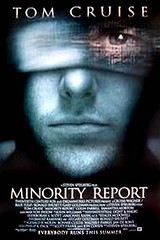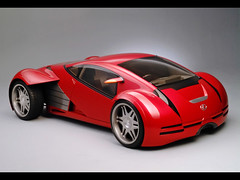 I watched Minority Report for the umpteenth time this evening and kept track of the various futuristic elements that were portrayed in the film.
I watched Minority Report for the umpteenth time this evening and kept track of the various futuristic elements that were portrayed in the film.Most of the ideas are quite plausible, and this is not by accident. During pre-production, Speilberg assembled a group of futurists and technologists to brain-storm the various futuristic elements that eventually made their way into the movie. According to Wikipedia:
In 1999, Spielberg invited fifteen experts convened by Global Business Network and its chairman, Peter Schwartz (and the demographer and journalist Joel Garreau) to a hotel in Santa Monica, California to brainstorm and flesh out details of a possible "future reality" for the year 2054. The experts included Stewart Brand, Peter Calthorpe, Douglas Coupland, Neil Gershenfeld, biomedical researcher Shaun Jones, Jaron Lanier, and former MIT architecture dean William J. Mitchell. While the discussions didn't change key elements needed for the film's action sequences, they were influential in introducing some of the more utopian aspects of the film, though John Underkoffler, the science and technology advisor for the film, described the film as "much grayer and more ambiguous" than what we envisioned in 1999.My list includes:
 - murder precognition (ie the ability to predict murders by converting human brains into 'pattern filtering devices')
- murder precognition (ie the ability to predict murders by converting human brains into 'pattern filtering devices')- holographic and fully interactive user interfaces
- genetically modified flora (including modifications like poison and mobility)
- immersive virtual reality
- self driving automobiles and smart roads (including roads that allow cars to traverse the walls of buildings)
- automobile lock-down (eg so police can seize control of an automobile)
- mag-lev vehicles (magnetic levitation)
- flying troop carriers
- retinal eye scanners

- robots endowed with AI, surveillance robots (eg robotic 'spyders' that perform search-and-scan sweeps, can problem solve and communicate with each other)
- fully automated factories (eg a car assembly plant)
- smart materials with the capacity for animated graphic display (eg cereal boxes with cartoons on them and scrolling headlines on magazine covers)
- tailored narcotics (eg. recreational drugs for "the educated")
- targetted advertising, holographic advertising ("Hey John Anderton, you could use a Guinness")
- holographic projection devices with removable media
- detention centres in which prisoners are in stasis but are fed a stream of images and experiences (grossly unethical and something I should blog about)
- non-lethal weapons, including sick-sticks (causing the person on the receiving end to projectile vomit), neural paralyzer (ie brain-cuffs) and audio guns (low frequency audio projectile weapons)
- hoverpacks(ie the 'ol rocket-pack idea)
- mention of molecular nanotechnology (a newspaper headline)
- eye transplants
Let me know if I missed any!

No comments:
Post a Comment